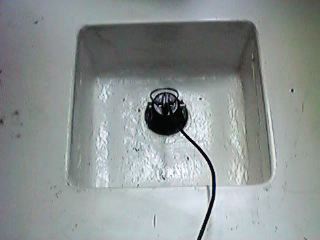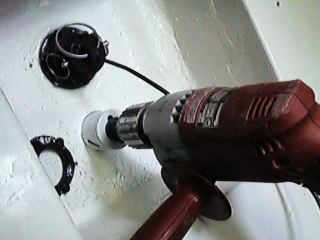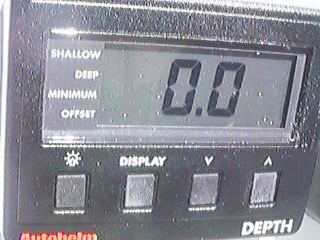
|
|
|
|
|
|
|
|
|
|
|
|
|
|
|
|
|
|
|
|
|
|
|
|
|
|
|
|
|
|
|
|
|
|
|
|
|
|
|
|
|
|
|
|
|
|
|
|

 Miracle Max - Depth Sounder
Miracle Max - Depth Sounder
Because the Miracle Max is a Water-ballasted boat, it would be difficult to install through-hull sensors. In the Catalina 250 they solved this by creating a pocket where the top and bottom of the ballast tank are joined, so through-hulls can be installed. You access it beneath the forward bunk, under the cabin table stowage. The ring-nut for the transducer and the transducer flange have the same diameter, so it makes a convenient template for placement of the transducer.

Now for the scary part. Drilling a hole in the bottom of the boat. It takes a good-size drill to cut a hole through about an inch of fiberglass. Ok, now that I have a hole I need to plug it. You can't cut the cable from the transducer to the read-out, so all of that cable needs to be stuffed through. I then applied a bedding of marine sealant (RTV). Now is not the time to skimp on sealant! When the transducer is pushed into the hole the excess sealant squishes out. I applied more sealant inside, including the threads. This puppy ain't never coming out! All that's left is to tighten the nut finger-tight (you don't want to over tighten it and break the plastic. Finally wipe off the excess sealant. When I installed the speed meter, I routed the cable under the starboard bench seat. But I had trouble getting around the galley. This time I routed it through the bow and along the starboard side where the upper and lower cabin-liners meet, under the teak accent. The upper and lower liners meet at several points along the side, so the cable needs to go over them, and rest on the little shelf behind the accent strip. The other one's behind the galley. To install the control head, one of the best Ideas is that the drill template sticks on with a weak glue. like a postit. That way you can place the control head very precisely. You need to drill through both of the bulkhead panels, to have room for the wires.

Send comments or questions to: bob@chex.stanford.edu